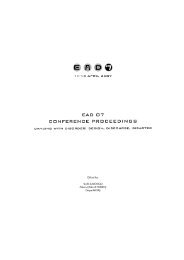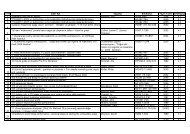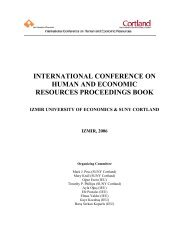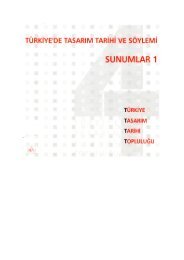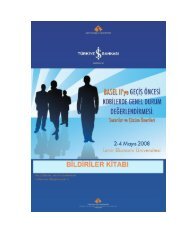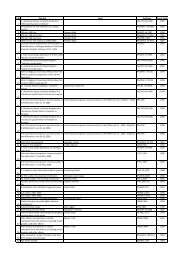- Page 1 and 2: 14 th International Congress on Com
- Page 3 and 4: SCIENTIFIC COMMITTEE Marc Goovaerts
- Page 5 and 6: Session1.3: Differential Equations
- Page 7 and 8: General Linear Model (GLM) Approach
- Page 9 and 10: • Mustafa Kahraman, Nurgul Gokgoz
- Page 11 and 12: • Ahmet Duman, Kemal Aydin Sensit
- Page 13 and 14: Session 7.2: Mathematical Modeling,
- Page 15 and 16: CONTENTS Committees v Invited Paper
- Page 17 and 18: An Application of a New Fuzzy Robus
- Page 19 and 20: Cem Kaanoglu Extension of Gamma, Be
- Page 21 and 22: xn+1 = pnxn−k+x n−(k+1) qn+x n
- Page 23 and 24: M.R. Akramin On exceedances based o
- Page 25 and 26: Koen Van Weert A Classification Pro
- Page 27 and 28: Reza Zolfaghari Analysis of Laminar
- Page 29 and 30: Alejandro Zarzo Trace Inequalities
- Page 31 and 32: xxiii Author Index 249
- Page 33 and 34: 2 NULISS: Non-Uniform Local Interpo
- Page 35 and 36: 4 Global Optimization In Practice J
- Page 38 and 39: Session 1.1: Applied Probability an
- Page 40 and 41: Multi-state system reliability unde
- Page 42 and 43: A Variant of the Choquet-Deny Theor
- Page 46 and 47: Rogue waves: power of mathematics i
- Page 48 and 49: Session 1.3: Differential Equations
- Page 50 and 51: Boundary value problems for the Hel
- Page 52 and 53: Step size strategies on the numeric
- Page 54 and 55: Modeling Facility Location and Supp
- Page 56 and 57: A DEA based approach for solving th
- Page 58 and 59: Session 1.5: Numerical Analysis and
- Page 60 and 61: An Application of a New Fuzzy Robus
- Page 62: Numerical Integration of a Fuzzy Ri
- Page 66 and 67: Session 2.1: Approximation and Inte
- Page 68 and 69: Hermite-Birkhoff interpolation prob
- Page 70 and 71: q-Statistical Convergence Serife Be
- Page 72 and 73: A novel 2D finite-volume method for
- Page 74 and 75: Session 2.2: Numerical Linear Algeb
- Page 76 and 77: The Powers of Anti(2k+1)-Diagonal M
- Page 78 and 79: On the properties of generalized Fi
- Page 80 and 81: A Shift Strategy for Superquadratic
- Page 82 and 83: A Hybrid Genetic Pattern Search Aug
- Page 84 and 85: Centralized Resource Allocation wit
- Page 86 and 87: A Regularized Modified Lagrangian M
- Page 88 and 89: uals from the element of the self a
- Page 90 and 91: On Koornwinder classical orthogonal
- Page 92 and 93: Some generalizations of multiple He
- Page 94 and 95:
Application of Padé approximation
- Page 96 and 97:
Session 2.5: Statistics and Data An
- Page 98 and 99:
Comparison of a New Robust Test and
- Page 100 and 101:
Comparing Estimation Results in Non
- Page 102:
Rough Set-based Functional Dependen
- Page 106 and 107:
Session 3.1: Mathematical Modelling
- Page 108 and 109:
A Multizone Overset Algorithm for t
- Page 110 and 111:
Vague DeMorgan Complemented Lattice
- Page 112 and 113:
Lobatto IIIA-IIIB Discretization fo
- Page 114 and 115:
Rough Oscillatory Singular Integral
- Page 116 and 117:
Improving the Gradient based search
- Page 118 and 119:
An Alternative Region-Based Active
- Page 120 and 121:
Session 3.3: Nonlinear Equations an
- Page 122 and 123:
The Periodicity of Solutions of the
- Page 124 and 125:
A modification on some improved New
- Page 126 and 127:
Parallel Newton-like methods for so
- Page 128 and 129:
Deriving Elastic Fields in an Aniso
- Page 130 and 131:
A Boundary Value Problem of the Fre
- Page 132 and 133:
A Study on the Multiple Logistic Re
- Page 134 and 135:
A new numerical method for solving
- Page 136 and 137:
Session 3.5: Mathematical Programmi
- Page 138 and 139:
Identification, Optimization and Dy
- Page 140 and 141:
Finding Efficient and Inefficient O
- Page 142 and 143:
Staff scheduling with priority cons
- Page 144:
1 October 2009, 10:30-12:45 PARALLE
- Page 147 and 148:
116 Some Properties of Q-Biorthogon
- Page 149 and 150:
118 Error Estimates for Discrete Sp
- Page 151 and 152:
120 Asymptotic Results for a Semi-M
- Page 153 and 154:
122 Session 4.2: Applied Probabilit
- Page 155 and 156:
124 On exceedances based on the lis
- Page 157 and 158:
126 On LIBOR and swap market models
- Page 159 and 160:
128 On the Semi-Markovian Random Wa
- Page 161 and 162:
130 A nonlinear preconditioner for
- Page 163 and 164:
132 Multilevel Factor Modeling as a
- Page 165 and 166:
134 Investigation of Large Eddy Sim
- Page 167 and 168:
136 Session 4.4: Mathematical Progr
- Page 169 and 170:
138 A Multi-Objective Mixed Integer
- Page 171 and 172:
140 Ranking Decision Making Units w
- Page 173 and 174:
142 An Efficient Computational Meth
- Page 175 and 176:
144 A Comprehensive Kansei Engineer
- Page 177 and 178:
146 Smoothing the Covariance Based
- Page 179 and 180:
148 Exponential-Negative Binomial D
- Page 181 and 182:
150
- Page 184 and 185:
Session 5.1: Mathematical and Compu
- Page 186 and 187:
A Classification Problem of Credit
- Page 188 and 189:
Multi-class classification algorith
- Page 190 and 191:
Efficient Multiplications in F55n a
- Page 192 and 193:
On the elliptic curves y 2 = x 3
- Page 194 and 195:
Global Optimization In Practice Jan
- Page 196 and 197:
Exponential Runge-Kutta methods for
- Page 198 and 199:
The Solution of the Bagley-Torvik E
- Page 200 and 201:
Session 5.4: Numerical Linear Algeb
- Page 202 and 203:
A Variational Algorithm of the GPBi
- Page 204 and 205:
Fuzzy Linear System: Satisfactory L
- Page 206 and 207:
On q-Szász-Durrmeyer Operators Hav
- Page 208 and 209:
On Bivariate Bernstein-Chlodovsky O
- Page 210:
2 October 2009, 11:00-12:30 PARALLE
- Page 213 and 214:
182 Newsvendor Characterizations fo
- Page 215 and 216:
184 Modeling Coordination Relations
- Page 217 and 218:
186 Session 6.2: Computational Meth
- Page 219 and 220:
188 An Inverse Problem of Finding C
- Page 221 and 222:
190 Topological Indices of Graph Op
- Page 223 and 224:
192 New approach for the constructi
- Page 225 and 226:
194 Modified Sinc-collocation metho
- Page 227 and 228:
196 Session 6.4: Mathematical Model
- Page 229 and 230:
198 Solving Distributed Optimal Con
- Page 231 and 232:
200 Topology of two separation bubb
- Page 233 and 234:
202 The Block-Grid Method for Solvi
- Page 235 and 236:
204 Automatic Zone Decomposition in
- Page 237 and 238:
206
- Page 240 and 241:
Session 7.1: Optimization II Chair:
- Page 242 and 243:
Application of Formal Languages in
- Page 244 and 245:
A Comparative Study on Parameter Es
- Page 246 and 247:
Interval Malmquist productivity in
- Page 248 and 249:
Parameter Interval Estimations thro
- Page 250 and 251:
Trace Inequalities for Matrices Ram
- Page 252 and 253:
Approximation of patches by C r -fi
- Page 254 and 255:
Interval Malmquist productivity in
- Page 256 and 257:
Super efficiency in stochastic data
- Page 258 and 259:
X-ray Fluorescence Computed Tomogra
- Page 260 and 261:
Imprecise probability and applicati
- Page 262 and 263:
Session 7.4: Mathematical Programmi
- Page 264 and 265:
Criteria Function Efficiency Agains
- Page 266 and 267:
Estimation of reliability P (Y < X)
- Page 268 and 269:
Alternative Long-Run Analysis of Se
- Page 270 and 271:
Session 7.5: Mathematical Modeling
- Page 272 and 273:
Equations of anisotropic elastodyna
- Page 274 and 275:
References Courant and Hilbert (196
- Page 276 and 277:
Sensitivity analysis for criteria v
- Page 278 and 279:
Bounds on Estrada Index of Fulleren
- Page 280 and 281:
Abbasbandy, S., 137 Abbasi, A.O., 1
- Page 282 and 283:
Kinaci, I., 183 Kirlar, B.B., 161 K



